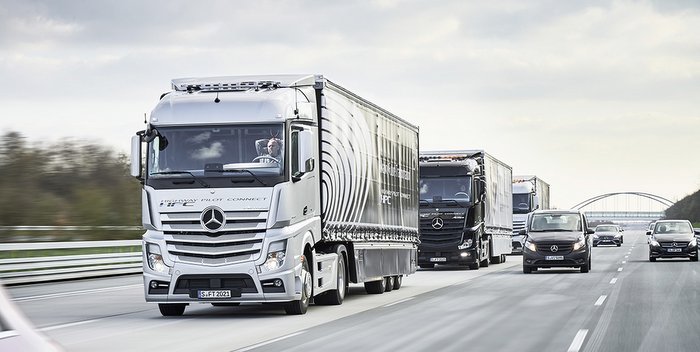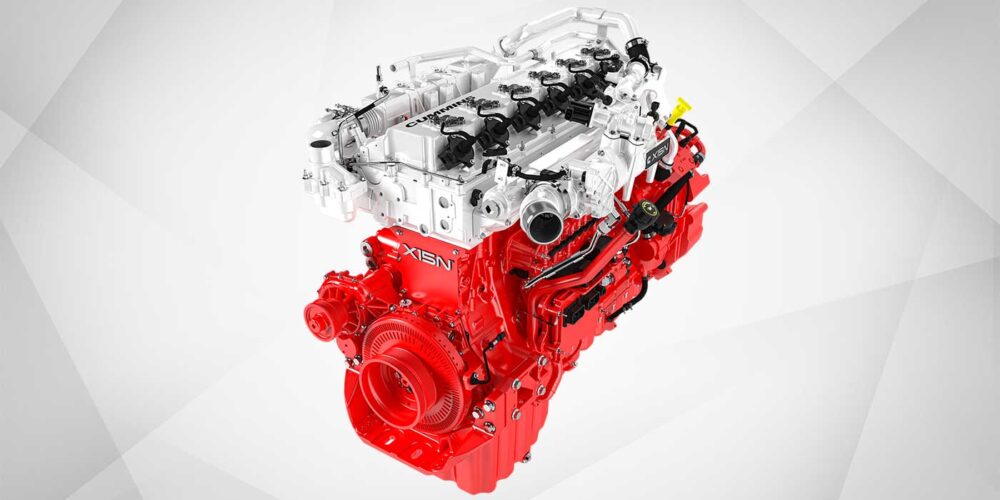Truck platooning technology often gets lumped into the overall autonomous technology conversation. While platooning is certainly a building block toward a more autonomous truck, its merits are worth investigating separately. The recent Trucking Efficiency Confidence Report looked at a two-truck platoon case study and found that a separation distance of 40 to 50 ft. could lead to an average fuel savings of 10% for the following vehicle and 4% for the lead vehicle.
Making a vehicle-to-vehicle connection in order to share operational data and operating, in concert, safely, enables platooning. This allows the following truck to shorten up the following distance to take advantages of the fuel efficiency savings. According to the North American Council for Freight Efficiency (NACFE) platooning report, the system requires the following technology:
- Collision avoidance system;
- Adaptive cruise control;
- MPG optimization systems;
- Vehicle transmission of sensor data;
- Vehicle reception of sensor data from other vehicles;
- Platooning software;
- Platoon MPG optimization software improving two-truck platoon performance; and
- Enhanced platoon MPG optimization software, which would allow more than two trucks to optimize performance.
Today, that technology is a reality.
Earlier this year, Daimler showed off Highway Pilot Connect, a vehicle-to-vehicle (V2V) connection that enables platoons of up to three trucks to operate in autonomous mode. The system communicates using WLAN standard IEEE 802.11p, which is used only for automotive V2V applications and utilizes a combination of a radio processor and a dual multiband HF transmitter/receiver. This means that information critical to safety, such as recognizing emergency braking when it occurs, can be transferred within 0.1 seconds.
In October, WABCO announced that it is working with Peloton Technology on truck platooning solutions. The two companies plan to leverage their respective technologies—WABCO’s OnGuardActive collision mitigation system and Peloton’s proprietary platooning technologies. WABCO’s OnGuardACTIVE collision mitigation system offers the 77GHz radar sensor, a key enabler of the platoon’s trucks. When necessary, it provides active braking to avoid or mitigate impending rear-end collisions. Peloton’s systems enable platooning through advanced vehicle-to-vehicle wireless communication, enabling tractor-trailers to accelerate and brake together and safely operate at closer distances to gain aerodynamic efficiencies.
Peloton’s system processes real-time data gathered from sensors linked to other vehicle active safety and automation systems, including WABCO’s OnGuard emergency braking system and from WABCO’s source of instant digital information about the vehicle’s systems and their performance. Peloton’s Network Operations Center also supervises the platooning trucks, allowing platooning only where, when and how it is safe to do so.
Peloton is a name you’ve likely heard before. In April of 2015, Volvo Group Venture Capital, a subsidiary of the Volvo Group, announced that it was investing in Peloton Technology. Platooning has been one of Volvo Trucks’ focuses in the past several year. It was also the first OEM to lead a platoon.
“We see this as an evolution, not a revolution, in trucking,” said Mike Roeth, executive director of NACFE. “What emerged to us as a definite next step is what we are calling two truck attuning—that is, connecting the acceleration and the braking and not steering. In this first technology approach, the ability to connect the acceleration and braking through vehicle-to-vehicle communications does gain the fuel savings of improved reduced drag for both trucks. It’s more the rear truck than the front truck, but you start to see this difference in fuel economy at the 50 to 40 ft. following distance.
“As you decrease the gap, the fuel economy in both trucks improves,” Roeth continued. “There’s a big fuel economy difference between 50 ft. and 20 ft. When you get to a very close following distance—around 20 ft.—then the design of the trucks may need to change because the first issue is cooling air to the following truck. So that’s why we think that there will be a first adoption of linking two trucks up with only braking and accelerating and the business case for lane keeping and steering, as well as other automation functions down the road, will come later.”
While the technology that enables platooning advances, there are still plenty of questions to be answered. Chief among them are ROI, platoon integrity (how the platoon will react to other vehicles on the road), and system security. The payback on platooning technologies will, like most equipment, be based on the fleet’s application and ability to produce viable platooning time within its operation. The platoon integrity and system security, however, rests squarely on the soundness of the platooning system itself. While today’s systems currently utilize the encryption meant for vehicle-to-vehicle communication, there is still a long way to go.
“The industry is still very, very new, and the [vehicle communication] standards aren’t that well defined,” said Rick Mihelic, NACFE program manager for Mihelic Vehicle Consulting LLC, who was involved in the writing of the NACFE confidence report. “Bandwidth issues, speed and everything else will be a factor, and we’re just going to have to see where it goes over the next few years.”
In terms of security, the report explained that the technology is still in its infancy and that it’s an issue that solution providers are investigating. In the report, one unnamed OEM stated, “In the real world, I think fleets will pursue platooning cautiously. But we need to develop a secure electronic ‘handshake’ between two trucks and a way to determine who will lead an follow, and how speeds and maneuvers will be matched.”
“Platooning will be different a year from now and then five years from now compared to today,” Roeth stressed. He pointed out that for NACFE, this is the first forward-looking report that looks at a technology in development. “How those trucks are lined up, for instance, might be different in the early emerging days than it will be in a more mature platooning environment five to 10 years from now. NACFE hopes work on the different phases we see this technology going through, as well as how steering and lane keeping and other technologies emerge. We plan to be involved in that, but this [first report] is a basic understanding and sharing of what we learned.”
The full report can be found here.














